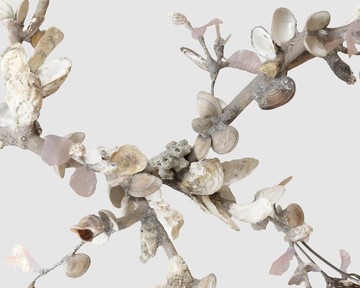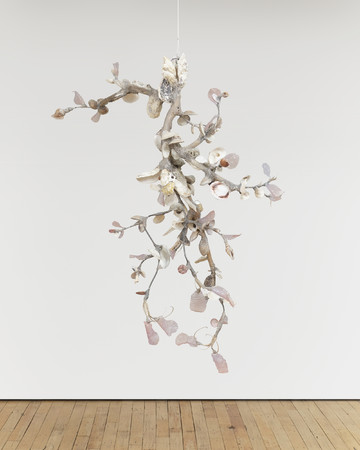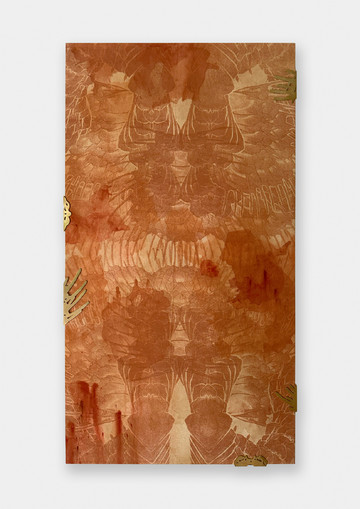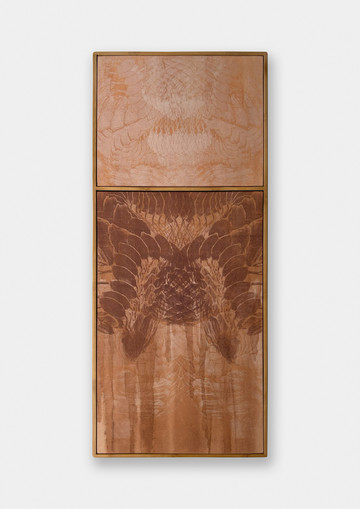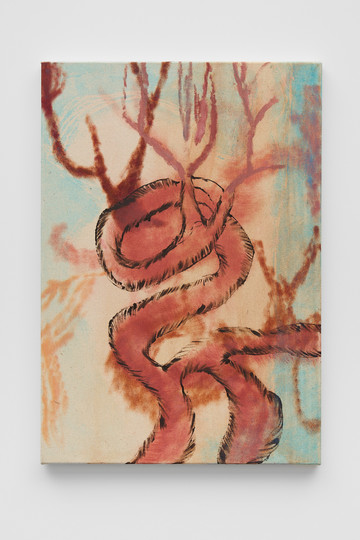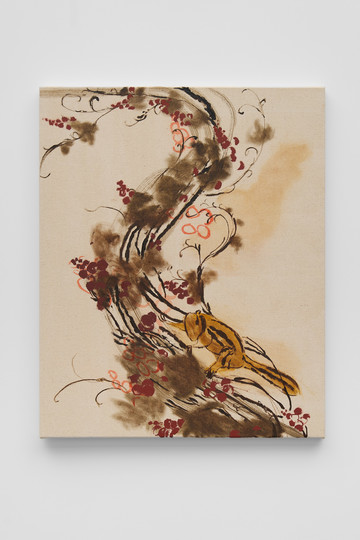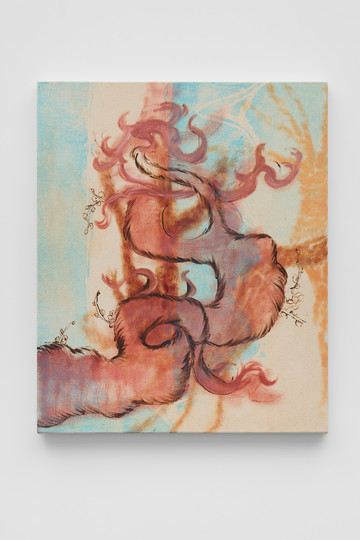Future Fossils
Gallery Vacancy is pleased to present Future Fossils at Paris Internationale 2025, featuring works by Shuyi Cao, Ines Katamso, and Fu Nagasawa. Bringing together practices that intertwine material transformation, myth-making, and inherited craft, this presentation traces the tension between permanence and change, what endures and what slips away. Upon the white sand, fossils are not only remnants of the past but anticipations of what may one day persist, gestures of care, the slow accumulation of memory, and the palpable gravity of making. The booth takes form as an edifice of riddles, where natural and synthetic sediments quietly intersect, skimming across thresholds of visibility and time.
Shuyi Cao’s sculptural compositions reflect on the transformation of materials through personal, ecological, and social entanglements. The Chinese artist’s family and friends offer her gifted remnants of oyster and clam shells, which she embeds with resin, glass, seeds and steel onto driftwood. In Dew Nester (2025), these records of intimacy and consumption settle into a grounded form, resembling a slow-growing fossil or botanical structure. Hanging in space, Xenophora IV (2024) gathers slender fragments into a suspended shape, its tendrils shimmering above the viewer like sea grass adrift in water. Cao, who has long been based in New York, also collects discarded plastic along the shoreline, where land and sea collapse into a blurred margin. Through what she describes as a metabolic process—melting, grafting, scanning, painting—she turns these materials into fragile constellations that linger between the organic and the technological. For Cao, this myth-making becomes a method of re-storying, an alchemical way of navigating damaged landscapes, recovering belonging, and conjuring wonder from the tidal uncertainties of the present.
Earth becomes both medium and witness in Ines Katamso’s compositions. Across stretched cotton, textured soil gathers into flowing lines and shadowed ridges. In her Naga (2025) and Biolateral series (2025), the French–Indonesian artist traces dragon-like silhouettes that emerge and recede, echoing mythical forms in Javanese cosmologies. These mineral traces draw from inherited methods of sensing the land, shaped by vernacular knowledge from the artist’s surroundings in Bali. Accents of bamboo or brass punctuate her paintings’ surfaces, grounding them in their material origins. Beginning with foraging, her process unfolds slowly into a mineral language of erosion and imprinting. Katamso reimagines the terrain as narrator. She weaves together ecological attention and animist belief, creating an active field of relations that speaks and remembers.
Kyoto-based artist Fu Nagasawa revisits ornamental traditions from East Asian folk art to develop a pictorial language attuned to rhythm and variation. Influenced by decorative patterns found on ceramics and utilitarian objects from five centuries ago in Japan and the Korean peninsula, his paintings reimagine these inherited motifs through a vocabulary of brushwork and gestures. Areas of translucent pigment drift across the canvas, where warm umbers meet coral tones and mineral greens, forming surfaces that recall hand-glazed finishes, subtly uneven, as if altered mid-process in the heat of a kiln. Part of this sensitivity stems from the artist’s family history in shipbuilding, anchoring his attention to how forms evolve under time and touch. The new paintings fold the past into the present, reapplying historical vestiges onto freshly painted grounds, as if fossilized emblems were gently reawakened within a contemporary skin.

Shuyi Cao
Shuyi Cao, born in 1990 in Guangzhou, China, currently lives and works in New York. She received a Bachelor of Laws and an M.A. in Public Administration from Fudan University, Shanghai, as well as an M.F.A. in Fine Arts at Parsons School of Design, New York. Cao’s sculptural and installation practice explores alchemical approaches to material transformation and the osmosis of knowledge. Moving between archaeological speculation and ecological fiction, her work reflects on porous entanglements among sciences, technocultures, mythologies, and cosmologies. Her methods span from ceramics and glass made with wild clay, sand, and mineral elements to digital fabrication such as 3D printing and simulated virtual environments, bringing together hand-crafted objects and technological artifacts. Conceived as paradoxical hybrids, simultaneously tangible and immaterial, these works appear as speculative fossils, opening portals for reflection on geotrauma, transcorporeal ecologies, and non-linear futures grounded in ancestral memory.
Recent solo and duo exhibitions include: Underwater, on Fire, UCCA Clay Museum, Tangshan, 2025; Oui, dire!, 11th Biennale nationale de sculpture contemporaine, Quebec, 2024. Group exhibitions include: Pacific Standard Time: Art x Science x LA, Orange County Museum of Art, California, 2025; Re-enchantment, Thaddaeus Ropac, London, 2024; Tales of the South, He Art Museum, Foshan, 2023; Land of Exile, Aranya Art Center, Beidaihe, 2023; Do Not Black Out, Ming Contemporary Art Museum, Shanghai, 2021, among others. She has participated in residencies at Massachusetts Museum of Contemporary Art (MASS MoCA), New Museum’s NEW INC, Banff Centre for Arts and Creativity, Guangdong Times Museum, and Power Station of Art, Shanghai. Cao is currently a visiting assistant professor at Pratt Institute and the founder of Transmaterial Lab.
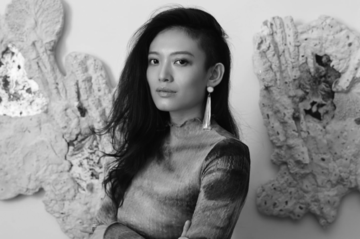
Ines Katamso
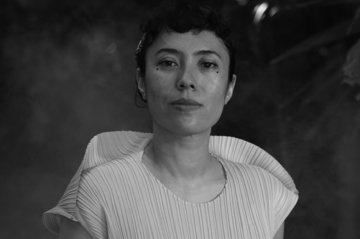
Ines Katamso, born in 1990 in Yogyakarta, Indonesia, now lives and works in Bali. She studied art and design at Lycée Léonard de Vinci, France, from 2005 to 2008, and textile and fashion at La Calade, France, from 2008 to 2011. Katamso’s practice adopts an approach that is both scientific and spiritual. Evolving from her studies of micro-organisms, bacterial morphogenesis, and fossils, she explores the ways we relate to the environment and to inherited systems of belief. With an ecological mindset, she revisits traditional craft techniques and employs recycled materials to create works that are at once sustainable and timeless. Situated between an archaeology of the future and a reinvention of vernacular mythology, her hybrid entities combine the organic and the artistic, the traditional and the futuristic.
Recent solo exhibitions include: Welcome to the Plastic Age, Institut d’art contemporain, Biennale de Lyon, Lyon, 2024. Selected group exhibitions include: Thresholds, White Cube, Hong Kong, 2025; Ramalan, Art Jog, Yogyakarta, 2024; Butterfly Eyes, Tang Contemporary, Bangkok, 2024; Biophilia, ISA Art, Jakarta, 2024; Enter Eden, Metis, Singapore, 2024; Titicara, Selasar Sunaryo, Bandung, 2022; and Sensing Sensation, Semarang Gallery, 2021. Major commissions include Nawa Dewata, created for the G20 Summit in 2023, and Three Naga, Potato Head, Bali, 2022.
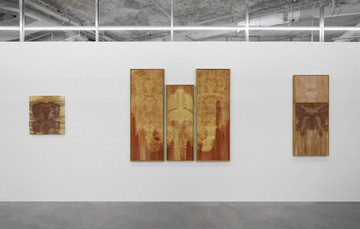
Fu Nagasawa
Fu Nagasawa, born in 1999 in Kochi, Japan, now lives and works in Kyoto. He received a BA in Oil Painting from Musashino Art University in 2022 and completed his MFA in the same field at Kyoto University of the Arts in 2025. Nagasawa’s practice revisits the visual and symbolic language of Japanese folk art and craftsmanship, drawing on motifs such as birds, plants, and ornamental patterns found in ceramics, dyed fabrics, and everyday objects. Working with both oil painting and woodblock printing, he reinterprets these inherited forms through layered compositions that oscillate between intention and accident. Irregular textures, misaligned imprints, and gestural brushstrokes echo the tactile nature of traditional techniques, where each variation, like the unpredictable results of kiln‑fired glazes, resists standardization. Through this process, Nagasawa shifts attention from decorative imagery to material resonance, proposing a renewed pictorial space in which forms rooted in secular culture are neither quoted nor rejected, but recontextualized and quietly transformed.
Recent solo and duo exhibitions include: Mark Making, Taka Ishii Gallery, Tokyo, 2025; Artificial-Natural, COHJU Contemporary Art, Kyoto, 2024. Selected group exhibitions include: COHJU Group Exhibition 2025, Kyoto, 2025; Second Signal and grid4, biscuit gallery, Tokyo, 2025; Kengo Kito Recommended Artist Exhibition “Floor”, Seibu Shibuya, Tokyo, 2024; Shibuya Style vol.17, Seibu Shibuya, Tokyo, 2023; and HOP, Kyoto University of the Arts Galerie Aube, Kyoto, 2023.
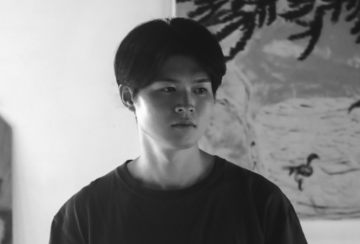
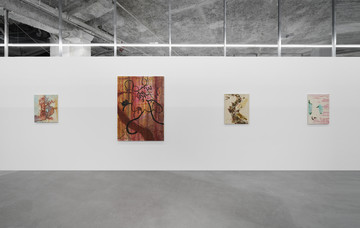
Inquiry: info@galleryvacancy.com

